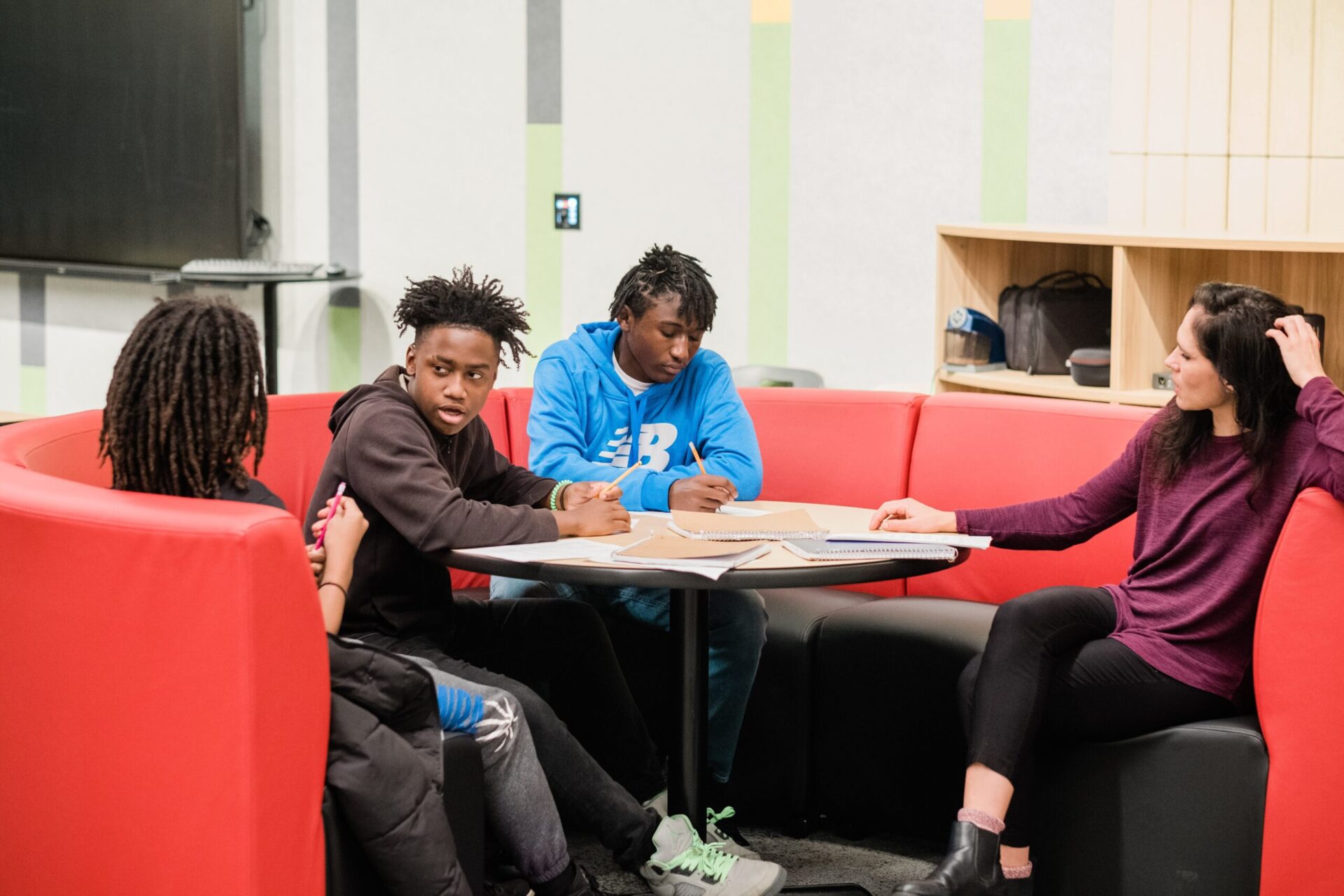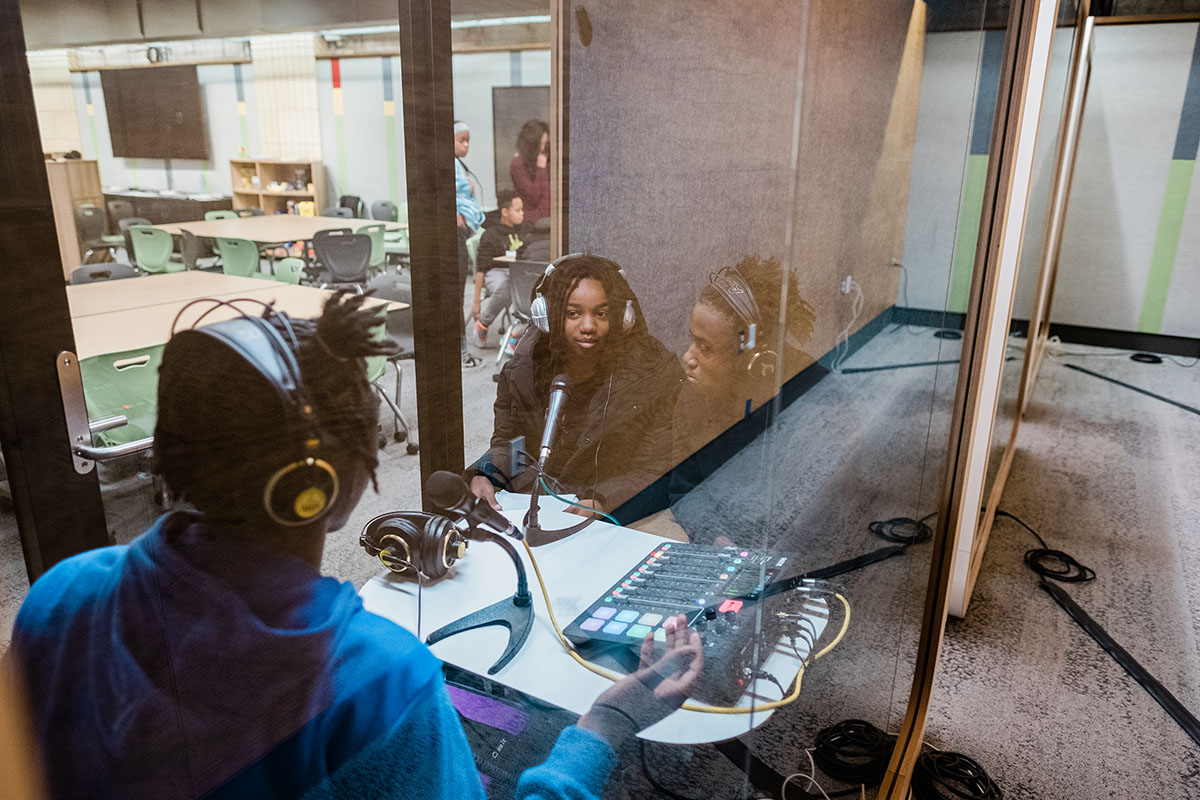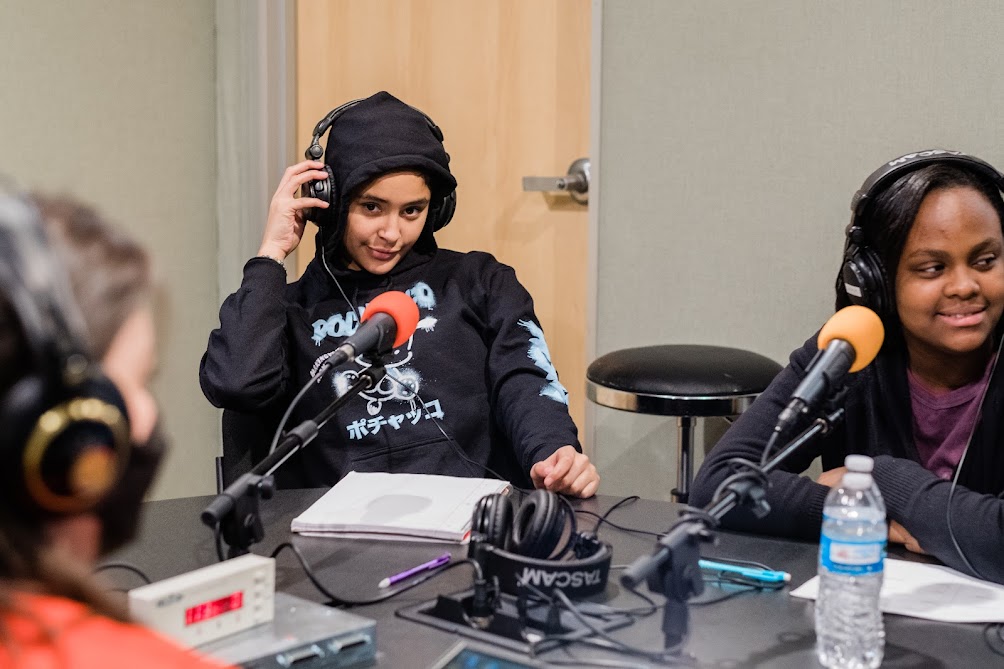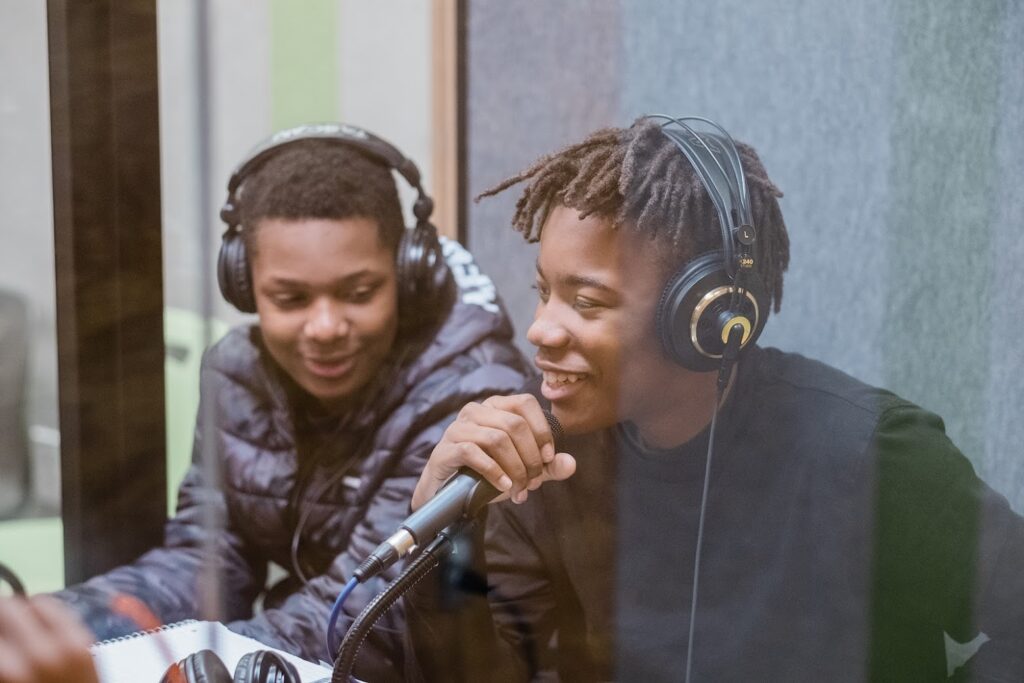For decades, SLB Radio Productions (SLB) has used professional multimedia tools to help small groups of students discover the power of telling their own stories. What if all kids could build those multimedia skills, while also reaping the many benefits of creating personal narratives about their learning? And what if these experiences could be threaded throughout the school day, helping students to grow as communicators and share their knowledge with others?
Middle school students at Manchester Academic Charter School (MACS) have had this experience thanks to a Remake Learning Moonshot grant. The results have been inspiring, and at times, surprising.
Who
Two members of SLB’s leadership team – founder and executive director Larry Berger and director of programming Deanna Baringer – collaborated with the administrators, teachers and students at MACS.
SLB and MACS had a strong relationship before the project began. And they are next-door neighbors: SLB’s studio is tucked inside the Children’s Museum of Pittsburgh and MACS’ middle school is located inside the MuseumLab.
So step one was clear: When SLB began envisioning this project, they had enthusiastic partners in MACS CEO Vasilios Scoumis and his leadership team. Next, they brought all voices to the table: “We got buy-in from our staff and their staff before submitting the proposal,” Berger says.
The timing was also good: SLB was in the process of expanding their facilities and seeking to design and test new curricula. MACS was eager to expand their personalized learning, adopt innovative new methods of assessment, and also deepen family engagement.
This project served all of those goals, with the needs of MACS’ middle schoolers at the center. Nearly 100% of these students are Black, and many are growing up in households facing trauma, economic pressures, and the impact of the COVID-19 pandemic.
So the work began in late 2021, and by spring semester 2022, this multimedia experiment was successfully underway.

Why
For years, the SLB team has seen the impact that happens when students are given the tools and the space to tell their own stories. They were especially interested in bringing this experience to kids from historically marginalized communities and embedding this work in a school setting. The goal was that as these students learn to center themselves – speaking about their personal learning, sharing their impressions and opinions about the academic work they’re doing, and conveying their knowledge to others – they can:
- Build Mastery. In the process of explaining their work and discussing it with peers for the recordings they make, students are grappling with the material and forming narratives that deepen their learning.
- Demonstrate Mastery. As educators seek new, better and more culturally sensitive methods of assessment, media-making allows students to demonstrate their knowledge in personalized, culturally-relevant ways.
- Share Knowledge. The learning these students demonstrate through pieces of media can be shared with other students. Perhaps most impactfully, it can also be shared with their parents.
- Develop 21st-Century Skills. These learners will work in a landscape where communication is key. As they learn to work with multimedia recording and editing equipment, and they become comfortable communicating in this way, doors can open.
The SLB team also knew that this work could eventually be scaled beyond MACS to other schools and to out-of-school-time learning settings. With good tools and adult mentors who can help support their creativity, children anywhere can reap these benefits.
What
During the 2021-2022 school year, teachers at MACS were given the chance to collaborate with the SLB team. Many were eager to weave media-making into their classes.
“We identified teachers who were particularly open to working with us and interested in integrating these projects into their classrooms,” Baringer says.
Although they’d expected to mainly connect with language arts and history teachers, something interesting happened.
“Science teachers across the board were very, very receptive to this which was very intriguing,” Berger says.
Once connections had been made, SLB then worked on a one-to-one basis with these teachers to plan their visits. Baringer would bring equipment to MACS (renovation of SLB’s expanded studio was still being completed) and record students discussing the work they were doing.
Baringer might ask: “What did you do in the past week for your project? What problems have cropped up in your experiments? What were the highs? What were the lows?
Tell us the story of what you went through.”
At first, the students needed time to acclimate. The earliest recordings were filled with quiet moments and students were often quite brief in their description of what they were learning.
But, Baringer says, “as the weeks progressed, the students so clearly were taking control over the situation. They understood what was happening. When they ran into problems, they were really able to talk through, ‘Well, this is what went wrong. And this is what we’ll do next time. And this is what we learned from this experience.’”
The students, teachers, and SLB team were building this new process together, learning and iterating along the way, and the students began to love it.
“We were able to explore and try a lot of different things, so that we made some discoveries about what works really well in the context of the school day,” Baringer says. “That’s something I think that’s special about this project: It’s not an afterschool thing. It’s something that we were trying very much to layer into the school day itself. So that was a challenge but also a really wonderful learning opportunity.”

Shifts
Students got excited about their learning and wanted to learn more in order to create more pieces of media. This method of documenting and assessing learning actually became an additional driver of learning. As one seventh-grader put it on a recording: “This project gave me the confidence and the motivation to take on other projects.”
Students not only got to demonstrate mastery, but they got to experience themselves as knowledgeable people whose voices matter. “If someone listens to these audio clips, they can legitimately learn from these students’ experiences,” Baringer says. For the students and for the adults involved, “it’s just very exciting.”
Students and parents more fully communicated. Once the MACS students began making media about their science experiments, they began talking about that science learning at home. And as they let their parents listen to the media they were creating, the adults had entry points to ask questions and learn more.
Berger points out that this last shift is especially promising.
“Most studies will show that parents become less engaged with their children’s activities as they hit middle school and beyond,” Berger says. In some cases, they may not be sure how to ask about what their children are learning, especially if it’s something they were never taught or they barely remember.
These podcasts full of students’ voices help teach the parents what their kids are discovering in school, and they do it in an approachable way.
“It’s kind of a gentle learning. You have to be so careful, especially with adults, not to make them feel like they have a deficit in not knowing something,” Berger says. “Most parents are going to be eager, I think, to listen to podcasts that their kids were part of. It creates a conversational element where they can say, ‘Tell me about this. How do you even swab a doorknob for bacteria? You used a petri dish?’”
At one point last spring, a parent stopped Berger to thank him for this project: “‘Oh, you’re with SLB,’ she said. ‘They’ve been working with my daughter.’ I said ‘Yeah. How’s that been going?’ She said, ’I can’t believe it. I ask her what she did in school, and on days you were there, she actually tells me!’”
Why it’s Working
Teachers played a key role, sharing the objectives of the units they were teaching and making sure the media-making would give students a chance to show mastery of that specific work. But students had the creative freedom to express their knowledge and discuss projects in their own ways.
When students had different impressions of what they learned, they worked out the details together and confirmed the correct information.
Science learning, in particular, was a place where this technique really flourished. “What we’ve learned is that there’s sort of a missing component in what kids were learning in science, which is developing their own personal narrative about what they learned – how their knowledge base grew – and to share that,” Berger says. “That’s something you can weave within an entire unit in a way that they never really had access to before. It’s almost like a multimedia lab report or a personal narrative of a lab report.”
Barriers Encountered
There was a need for flexibility. The location changed, because SLB’s expanded studio was still in the final stages of construction. And though the SLB team assumed they would do this work during the block of time that MACS devotes to student-directed projects, their recording sessions ended up threaded through various classes throughout the day. These changes were actually positive, but they required a willingness for all parties to adapt.
The classes in which this work was especially useful defied expectations. “We were absolutely convinced before we began the project that English, language arts and social studies were going to be the absolute killer application or the perfect use of this technique,” Berger says. “At least in this particular case, we were wrong. Science was really where we had the greatest impact. And we’d like to continue exploring that.”
This technique was clearly effective in helping students begin to demonstrate concepts they had mastered. But the SLB team is still working on refining the process so that they can detect the details that didn’t quite get learned. The SLB team experimented with different project styles in different classes, seeking to ensure that they could show learning while also identifying missed bits of learning. “Something that I think we’re still reaching for is how to create rubrics or create scaffolds for teachers to be able to actually use this as a form of assessment,” Baringer says. “It is a real challenge because teachers are so accustomed to traditional means of assessment.”

Advice From This Project for Like-Minded Efforts
Flexibility pays off. Many of the small changes in plans and surprises that this project encountered were quite positive.
Be patient. It took a bit of time for students to become comfortable with the new experience of speaking about their work and creating media from these recordings. But they quickly got comfortable and showed visible growth.
Media-making can be used to teach students to collaborate as a team, problem-solve while thinking out loud and express themselves clearly – all valuable 21st-century skills.
This work doesn’t have to be siloed as an “after school” project. Media-making can be woven smoothly into the fabric of the school day.
Authored by

Melissa Rayworth
Melissa Rayworth has spent two decades writing about the building blocks of modern life — how we design our homes, raise our children and care for elderly family members, how we interact with pop culture in our marketing-saturated society, and how our culture tackles (and avoids) issues of social justice and the environment.
